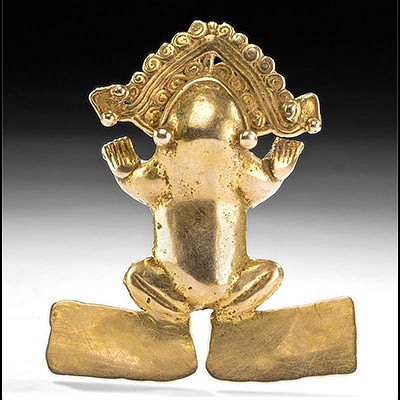Superb Large Roman Bronze Fitting - Minerva / Athena
Lot 30a
About Seller
Artemis Fine Arts
686 S Taylor Ave, Ste 106
Louisville, CO 80027
United States
Selling antiquities, ancient and ethnographic art online since 1993, Artemis Gallery specializes in Classical Antiquities (Egyptian, Greek, Roman, Near Eastern), Asian, Pre-Columbian, African / Tribal / Oceanographic art. Our extensive inventory includes pottery, stone, metal, wood, glass and textil...Read more
Categories
Estimate:
$6,000 - $7,500
Absentee vs Live bid
Two ways to bid:
- Leave a max absentee bid and the platform will bid on your behalf up to your maximum bid during the live auction.
- Bid live during the auction and your bids will be submitted real-time to the auctioneer.
Bid Increments
| Price | Bid Increment |
|---|---|
| $0 | $25 |
| $300 | $50 |
| $1,000 | $100 |
| $2,000 | $250 |
| $5,000 | $500 |
| $10,000 | $1,000 |
| $20,000 | $2,500 |
| $50,000 | $5,000 |
| $100,000 | $10,000 |
| $200,000 | $20,000 |
About Auction
By Artemis Fine Arts
Aug 13, 2020
Set Reminder
2020-08-13 10:00:00
2020-08-13 10:00:00
America/New_York
Bidsquare
Bidsquare : Fine Antiquities, Ethnographic & Fine Art
https://www.bidsquare.com/auctions/artemis-gallery/fine-antiquities-ethnographic-fine-art-5415
Features classical antiquities, ancient and ethnographic art from cultures encompassing the globe. Egyptian, Greek, Roman, Etruscan, Near Eastern, Asian, Pre-Columbian, Native American, African / Tribal, Oceanic, Spanish Colonial, Russian, Fine Art, so much more! Artemis Fine Arts info@artemisgallery.com
Features classical antiquities, ancient and ethnographic art from cultures encompassing the globe. Egyptian, Greek, Roman, Etruscan, Near Eastern, Asian, Pre-Columbian, Native American, African / Tribal, Oceanic, Spanish Colonial, Russian, Fine Art, so much more! Artemis Fine Arts info@artemisgallery.com
- Lot Description
Rome, Imperial Period, ca. 2nd century CE. A superb bronze chariot fitting finely cast via the lost wax process, depicting Minerva (the Roman version of Athena), the goddess of wisdom, medicine, art, commerce, and military victory, here depicted in her warrior guise, donning a crested helmet and battle dress with a finely detailed aegis of Medusa, a goatskin shield with a fringe of snakes in relief. According to Greek mythology, when Perseus killed the gorgon Medusa, whose face turned men to stone, he gave Medusa's head to Athena who placed it on her aegis. Size: 3.875" W x 8.375" H (9.8 cm x 21.3 cm)
Roman chariots were used for special events like triumphal processions. As a result, elaborate finials like this became de rigueur, lending a unique look to each chariot, where they were mounted on posts above each wheel. Furthermore, featuring Minerva on one's chariot would have added immense symbolism associated with military victory. Regarded as the daughter of Jupiter, from whose head she purportedly was born, Minerva was initially worshipped in Rome as one of the Capitoline Triad along with Jupiter and Juno. At first she was revered as the goddess of handicrafts, poetry, and the arts in general. Over time, Minerva's stature grew within the Roman pantheon and she became the most important focus of the Quinquatrus festival, which previously had been the domain of Mars, whose amorous affections she famously refused. The five-day festival began on March 19th marking the beginning of the Roman army's campaign season. Minerva also became associated with the concept of victory, as illustrated by Pompey's dedication of a temple to her following his successful campaigns in the east. Similarly, Emperor Domitian claimed the goddess as his protectress and in the second half of the 1st century CE commissioned a temple to her in the Nerva Forum in Rome.
Provenance: private Dere collection, New York, New York, USA collection; ex-private Pasadena, California, USA collection; ex-Los Angeles County, California, USA, acquired before 1990
All items legal to buy/sell under U.S. Statute covering cultural patrimony Code 2600, CHAPTER 14, and are guaranteed to be as described or your money back.
A Certificate of Authenticity will accompany all winning bids.
We ship worldwide and handle all shipping in-house for your convenience.
#157255Losses to one side of bust, peripheries of helmet, and helmet feathers. Abraded surface to one side of helmet. Gorgeous green and russet patina.Condition
- Shipping Info
-
All shipping is handled in-house for your convenience. Your invoice from Artemis Gallery will include shipping calculation instructions. If in doubt, please inquire BEFORE bidding for estimated shipping costs for individual items.
-
- Buyer's Premium



 EUR
EUR CAD
CAD AUD
AUD GBP
GBP MXN
MXN HKD
HKD CNY
CNY MYR
MYR SEK
SEK SGD
SGD CHF
CHF THB
THB
















